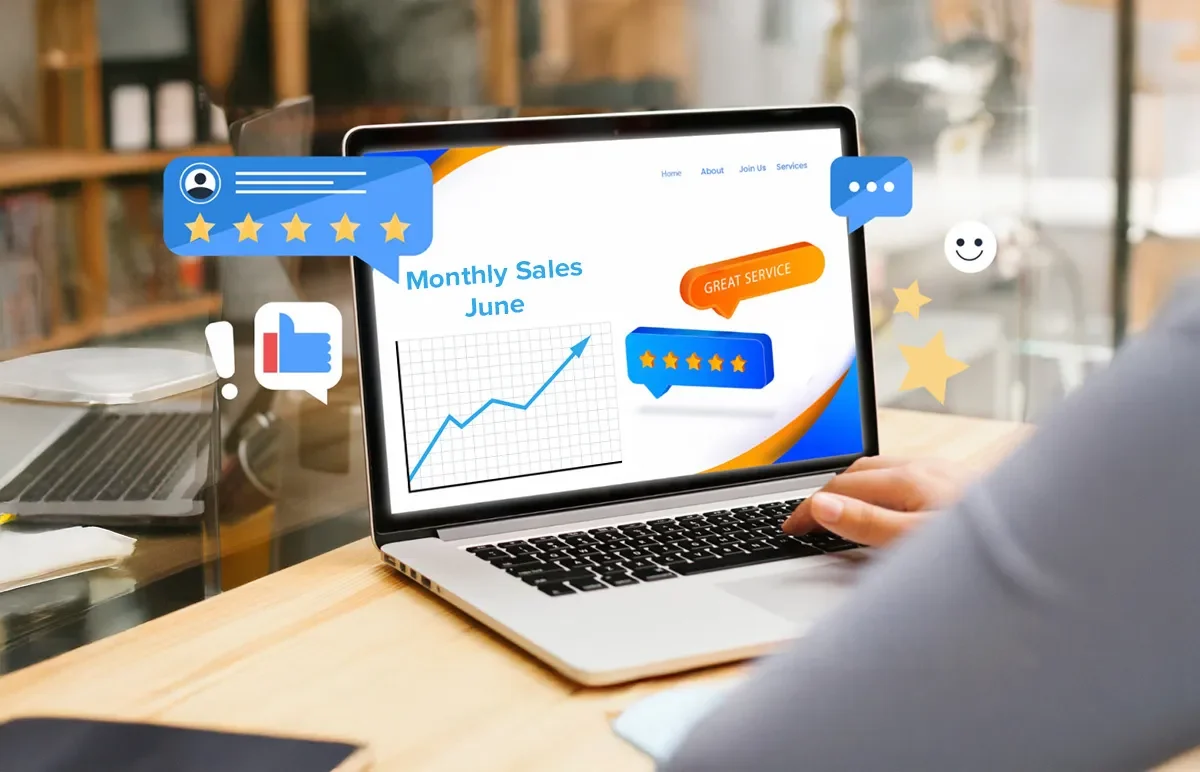Are you one of those marketers spending tons of money on marketing?
If yes, then you should be aware that you are completely ignoring the most powerful marketing engine sitting right under your nose: customer reviews.
93% of purchase decisions are influenced by reviews, which makes them a key commodity for businesses. This establishes irrefutably that reviews are more than just feedback—they are one of the key drivers of revenue growth.
Still, many marketers are unaware of the profound impact of reviews on their customers’ decisions, boosting SEO, and building brand trust. Instead of actively integrating them into marketing, sales, or product development strategies, companies let these valuable insights sit idle.
This article will explore the ramifications of having reviews, utilizing them to their full strategic potential, as well as the effects of advancing AI on their value and authenticity.
The Psychology Behind Reviews: Why They Trigger Action
To understand why customer reviews matter in boosting your brand revenue the way they do, we must look beyond their written words and delve into their psyche. Let’s see how reviews trigger buyers to take action.
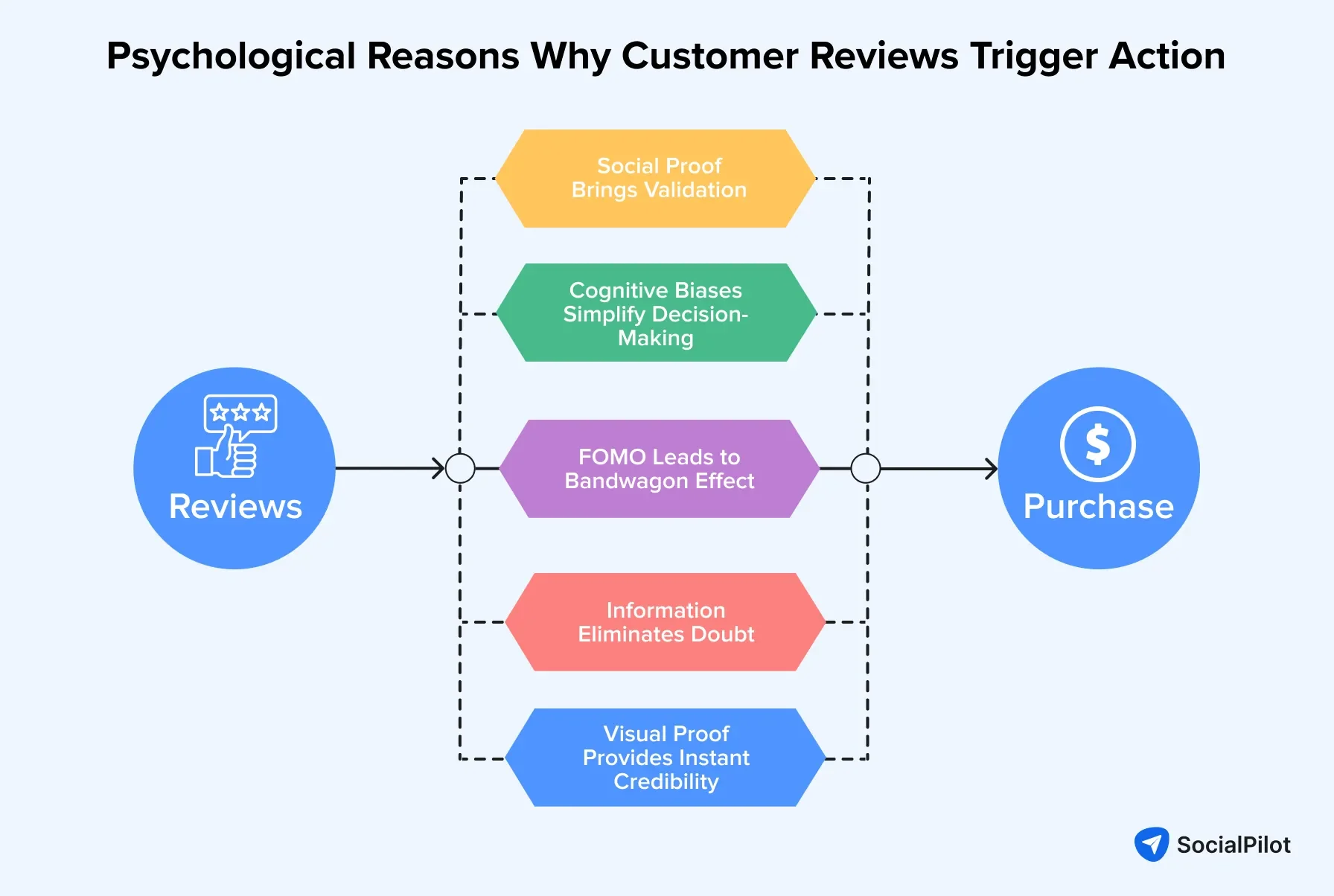

Seeking approval from other members of the community is a very common behaviour shown by people living in a society. Positive opinions from a large number of customers make the potential buyers believe in the product, thinking along the lines of “If people say this is a good product, then it must be!”
This means validation becomes a major contributor to building trust.
2. Cognitive Biases Simplify Decision-Making
Decision-making is a very complex process, and the brain looks for mental shortcuts for faster results. Here are some of the major biases that are activated by reviews:
- Confirmation bias: When reviews confirm your assumptions.
- Negativity bias: People tend to believe negative reviews more than positive ones.
- Time Effect: Recently received reviews are more believable, as people assume they are in line with the current state of the product.
3. FOMO Leads to Bandwagon Effect
People often show a strong inclination to follow the crowd. This phenomenon, also called the bandwagon effect, is triggered when a large number of people have reviewed a product, implying they have it.
That, in turn, creates FOMO in the potential buyer to make the purchase before it runs out and they miss it.
4. Information Eliminates Product Uncertainty
Humans tend to be doubtful by nature, and informative and detailed reviews help them educate themselves on the product under consideration. This holds especially true for higher spends as they pose more risk if the decision goes wrong.
5. Visual Proof Provides Instant Credibility
Reading positive feedback is a good thing, but people don’t always believe the written word completely. However, visual proof is concrete proof and hard to misinterpret, making it way more believable.
Hence, any reviews with videos and images in them are readily trusted by a reader, leading to instant decision-making.
Having explored why reviews matter on a cognitive level, we’ll now examine their practical role in shaping the customer journey, from first impressions to final conversions.
Reviews as a Revenue Multiplier Across the Funnel
The role of reviews can look simple at first glance. However, their omnipresence online makes them a part of the buying journey of consumers, guiding and influencing every step of the way.
If we break down the complete process, right from when they discover a product to when they decide to purchase or abandon it, consumers refer to reviews.
Here’s how it works:
1. Awareness Stage: Reviews Boost Visibility
All buyers’ journeys start from awareness or discovery. Most people search for information on the internet, which is also where they often discover products. A survey reveals that 77% shoppers search websites with reviews.
- When a solution is discovered for a known problem, reviews provide credibility to the discovered product, prompting action.
- If you discover a product and subsequently realise a relevant problem it can solve, reviews provide context for its usage.
2. Consideration Stage: Reviews Reduce Uncertainty
After discovery, consideration is a phase when potential buyers work to gather as much information as possible. They are trying to analyze whether the product is suitable for their cause by finding answers to questions such as:
- Will this actually solve my problem?
- How does this compare to other options?
- Is it worth the price?
- What is the opinion of other users?
Since they don’t have direct access to the actual product, customer reviews act as substitutes for actual trial experiences. If they can find a considerable number of recent reviews, they act as valid sources of first-hand information.
Once all the information has been gathered and stats compared, the consumer takes the final decision. During this stage, the quantitative and qualitative perception of reviews on the platform they are looking for may play a pivotal role in the purchase decision.
Reviews can either support the decision the consumer has made or dissuade them from the opinion they have formed. This is where reviews actually lead to conversions, and their visibility at the right spots matters the most.
4. Retention Stage: Reviews Drive Post-Purchase Loyalty
Smart marketers know the sale is just the beginning. To drive repeat purchases and long-term loyalty, you need to keep customers engaged with your brand beyond that initial transaction. Here, people seek out reviews of other customers to compare their own experiences with others.
In case of any difficulties with usage, positive feedback about your support team, as mentioned by others, goes a long way in reinforcing trust and patience. This makes them stay with your brand, repurchasing when the time comes. Building a consistent buyer base helps keep your afloat, bringing in regular revenue.
5. Advocacy Stage: Reviews Create new Customers
If your product or service has been satisfactory for the consumer and their post-purchase experience has kept them loyal, chances are, they would recommend others to use it too.
Now, you can nurture happy customers to review your product. The acquired reviews from satisfied customers are authentic social proof that can bring new ones and multiply your revenue growth.
Mapping the entire user journey proves the undeniable influence reviews have on every part of the decision-making process. But if ignored, there can be some very noticeable repercussions.
Brand awareness may not be entirely dependent on reviews, but perception is a different matter. When it comes to forming opinions, authentic customer reviews are what will shape your brand’s identity and drive your revenue ahead.
However, too many marketers are blind to the goldmine in their inbox. They dismiss reviews rather than using them as the organic marketing opportunities that they present. If you are unaware of what this negligence can do to your growth, here’s a list of pitfalls you’ll face:
1. Poor Discoverability Takes Away Visibility
In the absence of reviews, your brand will miss out on the exposure it can otherwise gain with them. If you are not actively utilizing available review machinery, you are ignoring the chances of appearing to more potential customers on their search results.
Search engines like Google prioritize businesses that have frequent, quality reviews, treating them as signals of credibility and relevance. When your reviews dry up, your organic reach shrinks as well, leading to fewer clicks, fewer leads, and ultimately less revenue.
2. Insufficient Credibility Leads to Trust Erosion
Reviews are the main requirement for your brand to build trust in the minds of your target audience. When they are evaluating their options, they actively browse multiple review platforms, seeking out feedback other buyers have provided.
Additionally, if your competitors have a better review game and you are lacking in that aspect, you will be at a huge disadvantage. Shoppers gravitate toward companies with strong, responsive reputations. So it’s more likely that they’ll pick a competitor over your product.
As shown earlier in the article, reviews play a major role in driving conversions. Data has proven that products with a minimum of five reviews have a 270% higher chance of being purchased than those with none.
When the buyer comes to the tail-end of their journey and needs to make the final decision, they seek that final validation in reviews despite having all the stats. Not having that final nudge can seriously cut back your conversions.
4. Missed Insights Hinder Strategic Improvement
The wealth of information that you can filter from reviews can not be found anywhere else. Through them, brands can uncover trends, pain points, and product blind spots.
Ignoring feedback means flying blind in the face of all that intel you can use to improve marketing strategies or product features. This could very well stagnate your brand’s growth overall.
To avoid all the pitfalls listed above, you must take serious measures and actively use the reviews you receive organically as well as boost feedback generation.
From Reputation to Revenue: Redesigning Review Strategy for Impact
It’s no longer a hunch—online reviews directly impact your turnover. From influencing purchase decisions to driving organic discovery, their role in revenue growth is well-documented. Now, let’s move from theory to action, actively generating, managing, and utilizing reviews to fuel sales and build a brand that people trust.
1. Review Solicitation
Let’s face it—buyers seldom write reviews willingly, and making them is the first and most cumbersome step of review marketing.
That moment right after a positive delivery experience, service call, or support interaction is perfect to ask buyers to give a review. But you can’t leave it to them to just do it on their own. It takes a nudge, a push, or even an incentive to make it happen. If you want to know how to ask for reviews effectively, we have created some templates that work well.
How Review Solicitation Helps:
- Actively asking your customers to review them increases the odds of your brand getting them.
- Requesting reviews at the right timing leads to them being of better quality as the memory of the product or service is still fresh.
- The practice of your brand reaching out to buyers imprints a positive image in their head, who care about their feedback.
Methods:
- Optimizing your Google Business Profile: Keep your profile complete and updated to make it easier for customers to find your business and leave a review directly from search or maps.
- Send them review requests and follow-up reminders: A gentle nudge after a positive interaction increases the chances of getting a review—don’t rely on customers remembering on their own.
- Give buyers incentives to encourage them to write reviews: Offer ethical rewards like discount codes or loyalty points to make writing a review feel worthwhile. Incentivized reviews, when used ethically, yield excellent results.
- Automate review request campaigns: Use tools to schedule and trigger review requests after purchase or service delivery, so you’re not manually chasing each customer.
- Personalize your review requests: Mention the customer’s name, purchase details, or experience to make the ask feel more genuine and increase response rates.
- Set up multiple avenues for buyers to leave reviews: Allow reviews via email, SMS, direct website forms, or platforms like Google and Facebook—meet them where it’s most convenient.
- Make the process of reviewing instantaneous and simple: Remove friction by using direct review links and mobile-friendly formats—no login walls or long forms.
- Do not spam their inboxes: One reminder is helpful, five is annoying. Time your follow-ups smartly and don’t bombard your customers with requests.
Here’s an example of a review request: minimal and convenient via a WhatsApp text:
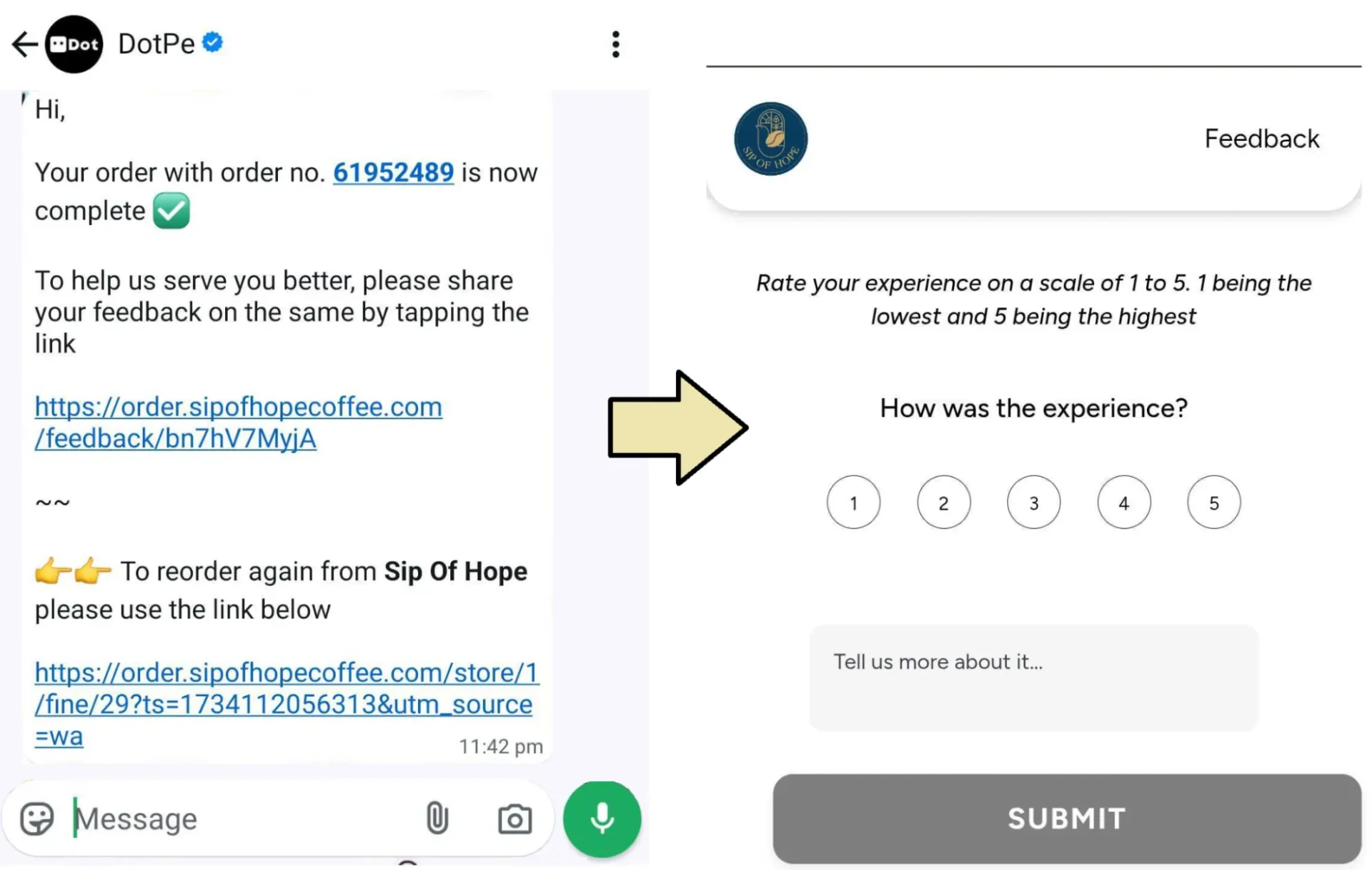

This process would require only a few clicks for your customer to leave reviews, making them more willing to do it.
2. Reviews Incorporation in Platform Design
Your own website is the canvas that showcases all aspects of your brand, from product information to values and USP. Smart businesses design their platforms in a way that they can incorporate reviews in the layout seamlessly.
Your customer feedback is best highlighted when it is interactive, searchable, and front and center. Adding review forms, links, or showcasing top feedback from previous customers is essential for your website.
How Incorporating Reviews in Platform Design Helps:
- Most users abandon their carts due to a lack of trust. However, a believable collection of reviews can fill that gap.
- It boosts your SEO because search engines see reviews as user-generated content, signaling authority, especially when marked up with schema.
- By showcasing relevant feedback directly on product or service pages, businesses eliminate the need for users to leave the site to read Google reviews.
Methods:
- Create separate pages for showcasing reviews: Create a dedicated “Testimonials” or “Reviews” page on your website. Display these quotes with the customer’s name (with their permission).
- Embed review screenshots from review platforms: Take screenshots of positive reviews from platforms and add them to your website as images.
- Add review widgets on key pages: Many popular review platforms offer embed codes or widgets that you can copy and paste directly into your website’s HTML. These widgets are designed to pull and display your reviews automatically. There are multiple ways to embed Google reviews on your website.
- Integrate review forms into your website: Create a form on your website where customers can submit their reviews directly. This can be a simple text field or include star ratings.
- Integrate comment section: For e-commerce sites or blogs, integrate review/comment systems directly into product pages or blog posts.
- Include video testimonials: Record short video clips of satisfied customers sharing their experiences and embed these videos on a dedicated testimonial page, your homepage, or relevant service pages.
Here’s a perfectly fitting example of how you can display shining customer testimonials into your website design:
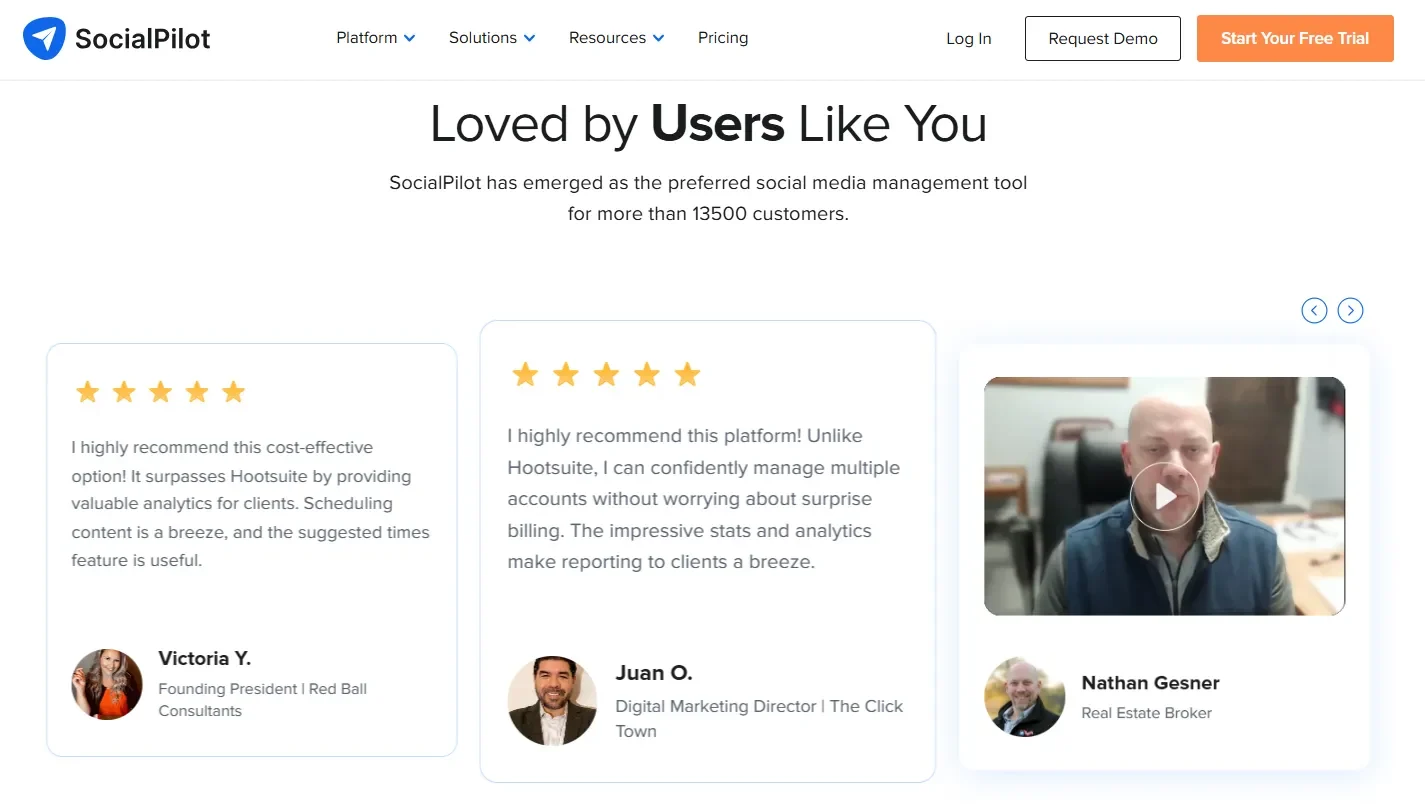

SocialPilot here has used a carousel design to show their valuable testimonials and mentioned the names and professional background of the reviewers. This helps potential clients relate to the product seeing how it has been used by people with similar requirements.
3. Review Moderation
Moderation is the process of monitoring, managing, and sometimes responding to user-generated reviews before or after they go public. Reviews matter if they are genuine feedback from your customers, even if not always positive. A huge majority of shoppers always actively seek out negative reviews due to negative bias.
But a lot of marketers practice review gating, which is hiding negative reviews and displaying only the positive ones. What they dont realise is that this reduces the credibility.
You must understand that the goal of moderation isn’t to censor negative reviews but to eliminate fake, offensive, or off-topic comments.
How Review Moderation Helps:
- This ensures your reviews remain trustworthy and readable.
- Moderation helps filter out spam, inappropriate content, legal risks, or abusive language that could damage your brand image.
- Helps verify reviews from real customers, reducing the risk of fake or malicious content skewing perception.
- Encourages informative, balanced reviews by setting clear guidelines and occasionally prompting revisions or clarifications.
- Helps prioritize reviews that contain valuable insights.
- Reduces legal and compliance risks or privacy-violating content from being published publicly.
Methods:
- Monitor reviews across multiple platforms: Regularly check reviews on all relevant sites to ensure you stay on top of customer feedback. This proactive approach prevents negative reviews from accumulating and gives you time to respond effectively.
- Respond to all reviews promptly: Whether the review is positive or negative, timely responses show customers you care and are attentive, which enhances public perception. You can refer to the collection of example responses to positive and negative reviews we have created.
- Establish clear review guidelines: Set transparent standards for what constitutes acceptable reviews, outlining prohibited content. You can publish the guidelines prominently on your website and review platforms.
- Maintain a balanced review profile: Don’t try to filter out negative reviews. Having a mix of reviews, both positive and constructive, creates authenticity.
- Encourage review updates: Occasionally ask satisfied customers to update their reviews, especially after an issue has been resolved or when you’ve made improvements based on feedback.
- Highlight “Most Helpful” or verified reviews: Showcase reviews that offer detailed, valuable insights, whether they’re “most helpful” as rated by other customers or verified by a trusted third-party platform.
- Utilize automated moderation tools: Use a review management tool to bring all reviews into one dashboard. This saves time to detect and filter out inappropriate content in real-time.
4. Strategic Review Data Usage
Every review is a mini-report from customers telling you what worked, what didn’t, and what they wish were different. When used strategically, it can influence product development, marketing, sales, and even customer support.
By analyzing and repurposing review data, businesses can make more informed decisions, craft more effective messaging, and unlock new revenue opportunities.
How It Helps:
- The use of review data helps identify recurring complaints or praise to guide upgrades, feature additions, or new service lines.
- Real customer stories and sentiment data help build credibility in marketing materials and sales decks.
- Reviews often contain long-tail keywords and user questions, which are perfect for blog topics or FAQ pages.
- It identifies patterns in negative reviews to fix systemic issues and reduce churn.
Methods:
- Run sentiment analysis tools: Use AI-powered tools to categorize reviews into positive, negative, or neutral themes and track emotional tone over time.
- Tag and categorize reviews by topic: Manually or automatically tag reviews by subject (e.g., pricing, customer service, shipping) for focused insights.
- Create a Voice-of-Customer Library: Build a database of customer phrases and emotions to fuel brand messaging that resonates.
- Incorporate data into A/B testing: Use high-performing review snippets in landing pages or ad copy and test against generic messaging.
- Visualize trends with dashboards: Set up review dashboards to track shifts in sentiment or recurring themes over months and quarters.
The practice of spreading customer reviews across various platforms, such as brand websites, social media, e-commerce sites, and third-party review platforms, is called review syndication. The goal is to increase the visibility of customer feedback, driving more potential customers to your business.
By amplifying positive reviews, businesses can build trust, improve SEO rankings, and ultimately boost sales and revenue. A vital part of review marketing, all marketers need to know how review syndication works to expertly leverage all invaluable feedback you have collected.
How It Helps:
- Displaying positive reviews across multiple platforms increases your credibility and attracts more potential buyers.
- When reviews are syndicated, they create multiple touchpoints on the web, improving your search engine visibility.
- By syndicating reviews across various platforms, you reach more potential customers in their preferred environment.
- When launching new products or entering new markets, syndication helps populate new listings with real reviews. This avoids the “zero reviews” barrier and builds trust from the start.
Methods:
- Aggregate and format reviews for distribution: Collect reviews from all sources, i.e., website, social media, emails, and third-party platforms, and standardize them to match the formatting requirements of each destination.
- Distribute reviews across multiple channels: Share reviews on high-visibility platforms like your website, Amazon, Google My Business, and social pages to maximize reach and meet buyers where they search.
- Leverage rich content formats: Enhance reviews with customer photos, videos, or in-depth testimonials to build credibility and create more engaging, authentic social proof.
- Ensure authenticity and avoid duplicate content: Authenticate and moderate reviews before syndication to maintain trust and avoid SEO penalties from duplicate or manipulated content.
Here’s a commercial shelving company that has shared a fantastic Google rating on their Instagram page along with a customer review.
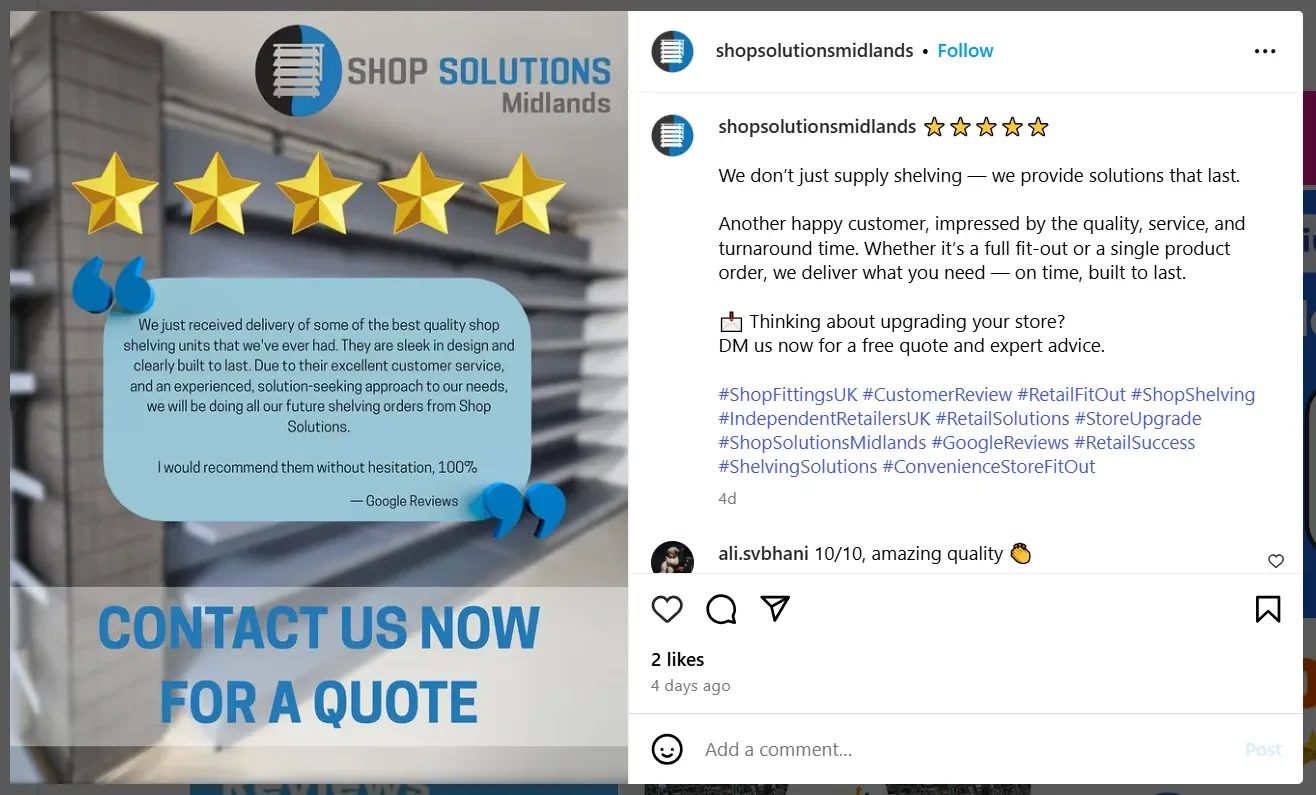

Reviews are something you have limited control over, as they are the audience’s prerogative, whether they leave feedback or not. Monitoring online reviews is another challenge. Your audience is everywhere, and you can’t possibly keep an eye on every possible channel where they are present.
Or can you?
Using versatile review management tools like SocialPilot Reviews can help you monitor incoming feedback, generate more reviews, review insights, respond to the audience, and leverage these reviews for carving out an irrefutably credible brand image.
SocialPilot Reviews has a lot to offer to marketers and businesses to strengthen their brand and bring in revenue through these organic assets. Let’s take a look at the tool’s capabilities.
Centralized Management: Handling Reviews Across Multiple Platforms from One Dashboard
The review management tool helps businesses manage their reviews from various platforms within a single, user-friendly dashboard, including Google, Facebook, Yelp, and more.
The business impact is obvious. You’ll be able to respond faster to all feedback, strengthen customer relationships, and maintain brand consistency across all review platforms. Instead of scrambling to keep up with scattered feedback, you’ll get a clear, consolidated view.


Streamlining Review Collection: The Power of Automated Requests
The automated review campaigns feature will help you generate customer feedback way faster than passive review reception. By automating review requests via email and SMS, businesses can increase the likelihood of receiving reviews, which might otherwise be missed.
You can create personalized and on-brand review campaigns and keep them running on autopilot, duplicate successful ones, and even save them as templates for later use.
Elevating Customer Trust: Integrating Reviews into Your Website
The platform provides customizable review widgets that allow businesses to feature customer reviews directly on their websites. You can also find specific widgets that, rather than showcasing reviews and ratings, ask people to leave feedback.
These widgets require no coding knowledge to be integrated into your website. Additionally, customizable widgets allow businesses to maintain brand consistency while showcasing customer feedback.
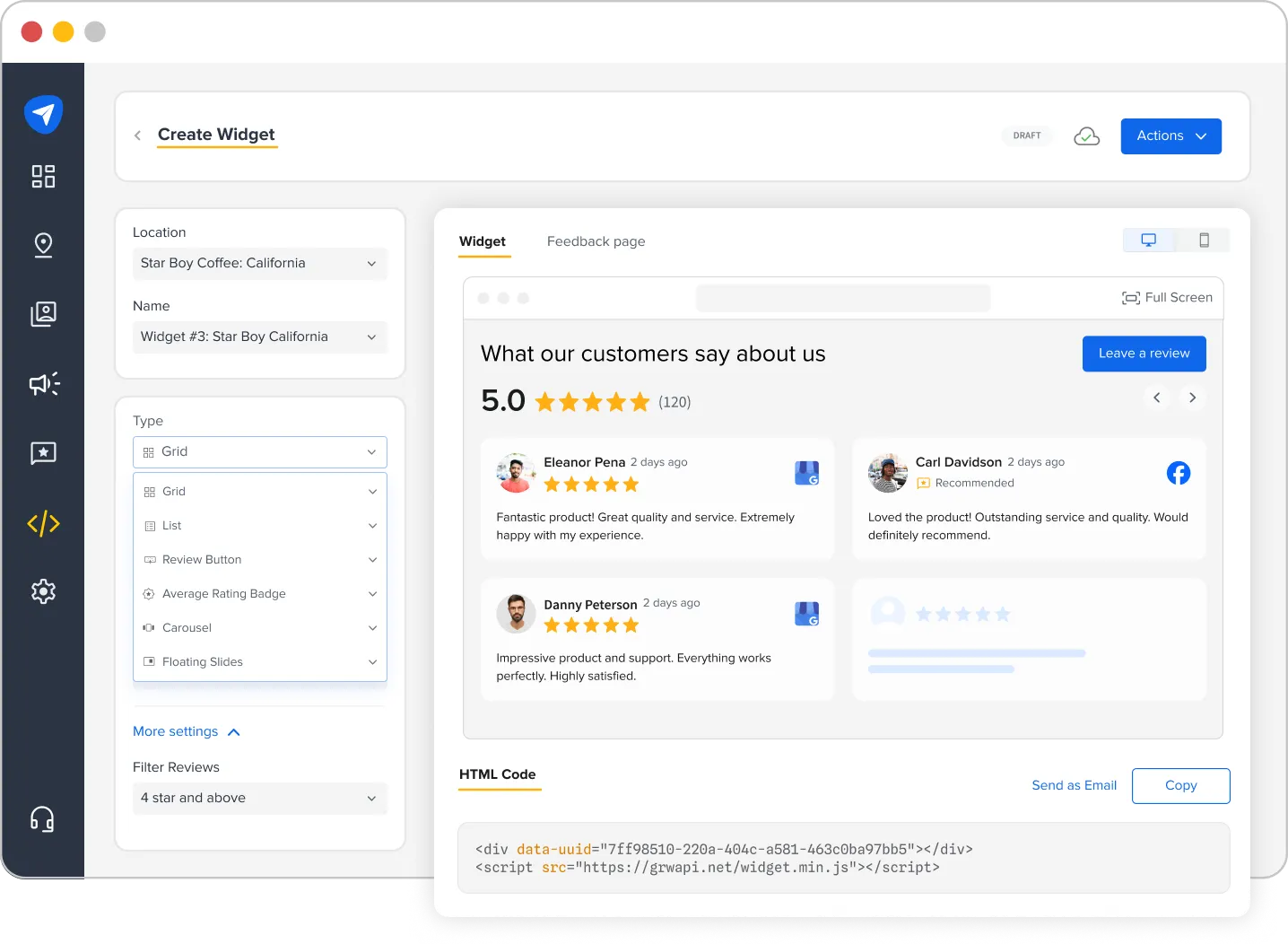

Data-Driven Decisions: Gaining Insight from Review Analytics
With SocialPilot Reviews, businesses can track and analyze reviews in detail, including rating trends, customer location data, and associated brands. This provides actionable insights that can guide product development, marketing strategies, and customer service improvements.
Expanding Reach: Sharing Reviews to Amplify Brand Visibility
Perhaps the most crucial element of review marketing is sharing them for the right people to see. SocialPilot Reviews enables businesses to easily share customer testimonials across multiple social media platforms.
The social sharing of reviews allows your business to set the ball rolling on engagement. These conversations reach a wide audience, providing an opportunity to tap into how the audience perceives your brand, gaining some serious insights.


So you see, ticks all the boxes to transform audience reviews into business growth and drive revenue. From seamless review solicitation and management to amplifying social proof across platforms, it’s the all-in-one tool that ensures reviews don’t just sit idle—they fuel your business growth. Let your reviews do the talking, while SocialPilot handles the rest.
The New Frontier: AI, Fake Reviews, and the Trust Economy
Customer reviews used to be straightforward—real people sharing real experiences. But now? It’s gotten complicated. With AI churning out fake reviews and unscrupulous competitors rigging the system, figuring out what’s genuine has become a real headache for both businesses and shoppers.
The Rise of AI-Generated Reviews
AI tools are now capable of generating fake reviews that mimic the language, tone, and structure of genuine customer feedback. While this may seem like a quick way to boost brand visibility, it compromises trust. Fake reviews—whether positive or negative—can distort a brand’s reputation, mislead potential customers, and create false competition in the marketplace.
This is how fake reviews damage audience trust and your business:
- Deceptive Business Practices: Customers may be misled into thinking a product or service has more positive reviews than it actually does, only to be disappointed by the real experience.
- SEO and Algorithm Manipulation: Fake reviews can skew algorithms and affect search engine rankings, leading to unfair advantages for dishonest businesses and a negative experience for consumers.
- Legal Consequences: Many platforms, including Google and Amazon, have strict policies against fake reviews. Violating these policies can result in penalties, account suspensions, or legal action.
Importance of Transparency and Verification in the Trust Economy
In today’s AI-dominated socialscape, customers demand authenticity with proof. If they feel misled or manipulated by fake reviews or AI-generated content, they are likely to abandon your brand in favor of competitors.
Here are the elements of ingenuity that your brand needs to maintain audience trust in your review marketing efforts:
- Transparency is a necessity: In an age of AI-written and fake reviews, disclosure builds credibility and shields your brand in case of backlash over any perceived dishonesty. So, make sure to clearly disclose when reviews are incentivized or AI-generated.
- Verification helps separate real from the fake: Use verified reviews that require proof of purchase or authentication. This step ensures that reviews come from legitimate customers and reflect real experiences, boosting credibility and reliability.
- Engagement creates a connection with the audience: Actively engage with customers by responding to both positive and negative reviews. This shows that your business values feedback, addresses concerns, and is committed to improving, fostering a sense of trust and reliability.
- Trusted platforms bring widespread visibility: Leverage review platforms that emphasize verification, Google My Business, Yelp, and industry-specific review platforms where reviews are monitored and can be traced back to legitimate users.
Build the Review Engine Before You Spend More on Ads
Recognizing the untapped potential of reviews can help businesses save a lot of money and boost their revenue organically. The math behind this fact is pretty simple.
Reviews influence purchase decisions by driving awareness, enhancing SEO, boosting credibility, and fostering customer loyalty. In an era of AI-generated noise, genuine customer voices build a sustainable foundation for organic growth.
To unlock the power of reviews, integrate them into your business, from marketing to product development and customer support. Tools like SocialPilot Reviews can help streamline this process, giving you the tools to manage reviews efficiently and build lasting relationships with customers. You can take a free trial of the tool to experience its top-notch review management capabilities.
Make reviews a cornerstone of your strategy, and take control of your online reputation today!
